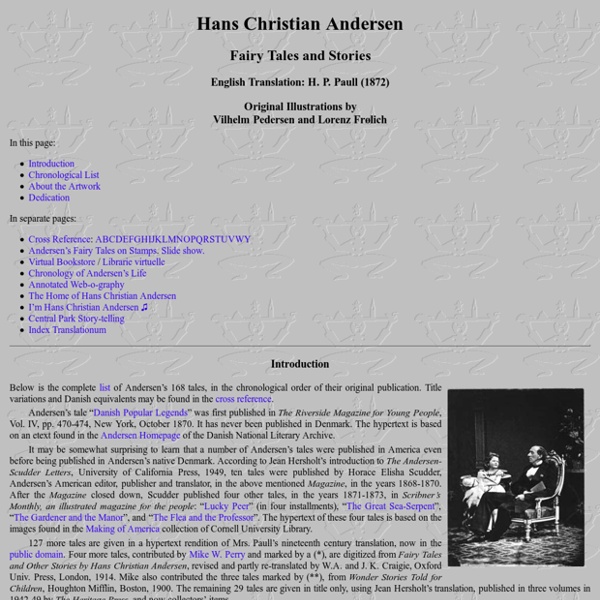



Storybook Patterns Snowmen at Night Mr Willowby's Christmas Tree The Foolish Tortoise Creepy Carrots! Creepy Carrots Craft / Word Sort Giraffes Can't Dance Kittten's First Full Moon Ten Little Ladybugs We're Going on a Nature Hunt I See Summer Rhyming Words Match The Carrot Seed: Activity Elmer: Coloring Sheet / Mask The Cow Loves Cookies The Very Lonely Firefly Little Blue Truck's Springtime The Very Quiet Cricket The Greedy Python There Was an Old Lady Who Swallowed Some Leaves The Day It Rained Hearts The Busy Little Squirrel The Watermelon SeedMinibook Dog's Colorful Day The Color Monster B&W / Feelings Jars Book
Annotated Fairy Tales, Fairy Tale Books and Illustrations The Internet Book Database of Fiction • Index page Active Voice Versus Passive Voice Today's topic is active voice versus passive voice. Here's a question from Brian in Iowa. He writes, “It drives me crazy when people write in passive voice. How can I teach people how to tell the difference between passive and active voice and to stay away from passive voice?” Well, Brian is right, the first step is to help people understand the difference between active and passive voice, because many people believe they should avoid the passive voice, but fewer people can define it or recognize it. What Is Active Voice? I'll start with active voice because it's simpler. Another example is the title of the Marvin Gaye song “I Heard It through the Grapevine.” What Is Passive Voice? In passive voice, the target of the action gets promoted to the subject position. If you wanted to make the title of the Marvin Gaye song passive, you would say “It was heard by me through the grapevine,” not such a catchy title anymore. Next: Is "To Be" a Sign of Passive Voice? Is Passive Voice Always Wrong? 1.
Free ebooks - Project Gutenberg Free Ready to Print Children's Picture Books with Matching Audio mp3's List of fairy tales A modern definition of the fairy tale, as provided by Jens Tismar's monologue in German, is a story that differs "from an oral folk tale"; is written by "a single identifiable author"; can be characterised as "simple and anonymous"; and exists in a mutable and difficult to define genre with a close relationship to folktales.[1] Jump up ^ Zipes, xvJump up ^ Laura Gibbs (July 12, 2003). "Don Giovanni de la Fortuna". Mythfolklore.net.
Free Online Novels HowStuffWorks "Structural Effects -- Poetic Meter" Put Your Feet Together: Building Meter There really is no limit to the number of syllables that can be contained in a foot. A poet could even create a meter that has ten syllables in each foot if he or she wanted to. Most feet, however, are made up of four or fewer syllables. An iamb is an unstressed syllable followed by a stressed syllable as in par-TAKE.A trochee is a stressed syllable followed by an unstressed syllable as in BAN-jo.A dactyl is a stressed syllable followed by two unstressed syllables as in CAP-it-al.An anapest is two unstressed syllables followed by a stressed syllable as in sev-en-TEEN.An amphibrach is an unstressed syllable followed by a stressed syllable and then an unstressed syllable as in ar-CHA-ic.A cretic is a stressed syllable followed by an unstressed syllable and then another stressed syllable as in TRAM-po-LINE. When you put the feet together, you get meter. Another tool poets have is structure. Sometimes poets put a whole sentence on one line.
55 great books under 200 pages Having no time doesn’t mean you have to stop reading. Just pick up the shorter book. Half Price Books, one of America’s favorite independent booksellers, asked their customers to recommend books under 200 pages that would be a perfect companion of a book lover. The image below displays top 55 recommendations. What book under 200 pages would you add to your reading list? Click or tap on the image below to see it in full resolution. Top article Best short books you can read in less than three hours. More infographics to check out: About Ola Kowalczyk Collecting bits and pieces about books and libraries in digital age.
Home - World Stories Magical Fairytales - Eugenio Recuenco (10 photos) Eugenio Recuenco is an award-winning fashion photographer from Spain. His unique style has been referred to as "cinematographic" and "pictorial" and his work has been featured in magazines such as Vogue and Twill. Eugenio Recuenco Author Yellow Pages Palabras Que Rimen (versión mejorada)